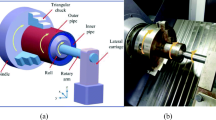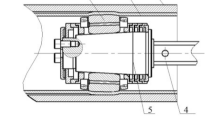Abstract
As a new attempt, ball spinning was used to manufacture a composite tube of copper and aluminum. The interface compatibility of the composite tube during ball spinning was investigated by combining finite element method with process experiment. The experimental results are in good agreement with the simulated ones. When the composite tubular blank which is composed of inner aluminum tube and outer copper tube is subjected to ball spinning, the composite tube keeps a good synchronism in terms of plastic deformation. When the composite tubular blank which consists of inner aluminum tube and outer copper tube undergoes ball spinning, the composite tube keeps a poor synchronism in terms of plastic deformation. The phenomenon indicates that the yield strength of the inner and outer tubes plays a significant role in the interface compatibility during ball spinning of the composite tube. According to the experimental and simulated results, the interface compatibility of the composite tube during ball spinning should meet the following requirements, including boundary condition of admissible velocity field, geometrical condition of composite tubular blank, steady flow condition of surface metal, and plastic yield condition of composite tube.
Similar content being viewed by others
References
Jiang W, Fan Z, Li C (2015) Improved steel/aluminum bonding in bimetallic castings by a compound casting process. J Mater Process Tech 226:25–31
Knezevic M, Jahedi M, Korkolis YP, Beyerlein IJ (2014) Material-based design of the extrusion of bimetallic tubes. Comp Mater Sci 95:63–73
Wang XS, Li PN, Wang RZ (2005) Study on hydro-forming technology of manufacturing bimetallic CRA-lined pipe. Int J Mach Tool Manu 45:373–378
Guo XZ, Tao J, Wang WT, Li HG, Wang C (2013) Effects of the inner mould material on the aluminum-316L stainless steel explosive clad pipe. Mater Des 49:116–122
Yu H, Fan Z, Li C (2014) Magnetic pulse cladding of aluminum alloy on mild steel tube. J Mater Process Tech 214:141–150
Lapovok R, Ng HP, Tomus D, Estrin Y (2012) Bimetallic copper–aluminium tube by severe plastic deformation. Scripta Mater 66:1081–1084
Xia Q, Xiao G, Long H, Cheng X, Sheng X (2014) A review of process advancement of novel metal spinning. Int J Mach Tool Manu 85:100–121
Ma F, Yang H, Zhan M (2010) Plastic deformation behaviors and their application in power spinning process of conical parts with transverse inner rib. J Mater Process Tech 210:180–189
Haghshenas M, Jhaver M, Klassen RJ, Wood JT (2011) Plastic strain distribution during splined-mandrel flow forming. Mater Des 32:3629–3636
Ma H, Xu W, Jin BC, Shan D, Nutt SR (2015) Damage evaluation in tube spinnability test with ductile fracture criteria. Int J Mech Sci 100:99–111
Shan DB, Yang GP, Xu WC (2009) Deformation history and the resultant texture and microstructure in backward tube spinning of Ti-6Al-2Zr-1Mo-1V. J Mater Process Tech 209:5713–5719
Mohebbi MS, Akbarzadeh A (2011) Fabrication of copper/aluminum composite tubes by spin-bonding process: experiments and modeling. Int J Adv Manu Tech 54:1043–1055
Jiang S, Ren Z, Xue K, Li C (2008) Application of BPANN for prediction of backward ball spinning of thin-walled tubular part with longitudinal inner ribs. J Mater Process Tech 196:190–196
Jiang S, Zhang Y, Zhao Y, Tang M, Li C (2013) Finite element simulation of ball spinning of NiTi shape memory alloy tube based on variable temperature field. T Nonferr Metal Soc 23:781–787
Zhang GL, Zhang SH, Li B, Zhang HQ (2007) Analysis on folding defects of inner grooved copper tubes during ball spin forming. J Mater Process Tech 184:393–400
Kuss M, Buchmayr B (2015) Analytical, numerical and experimental investigations of a ball spinning expansion process. J Mater Process Tech 224:213–221
Jiang S, Ren Z, Li C, Xue K (2009) Role of ball size in backward ball spinning of thin-walled tubular part with longitudinal inner ribs. J Mater Process Tech 209:2167–2174
Mohebbi MS, Akbarzadeh A (2010) Experimental study and FEM analysis of redundant strains in flow forming of tubes. J Mater Process Tech 210:389–395
Author information
Authors and Affiliations
Corresponding author
Rights and permissions
About this article
Cite this article
Jiang, S., Zhang, Y., Zhao, Y. et al. Investigation of interface compatibility during ball spinning of composite tube of copper and aluminum. Int J Adv Manuf Technol 88, 683–690 (2017). https://doi.org/10.1007/s00170-016-8803-1
Received:
Accepted:
Published:
Issue Date:
DOI: https://doi.org/10.1007/s00170-016-8803-1




